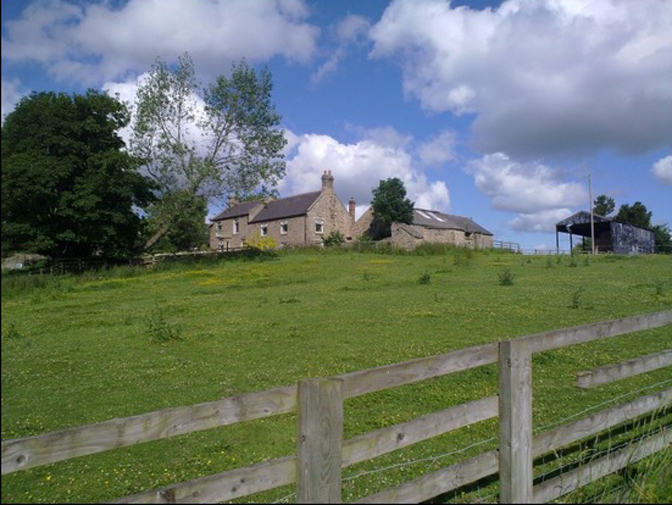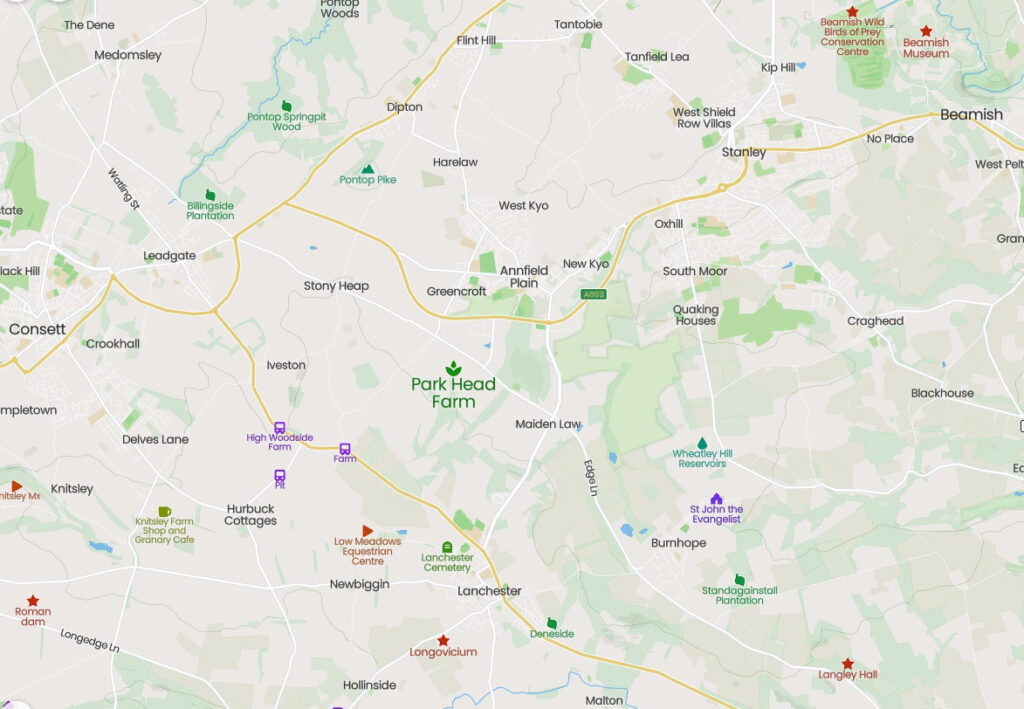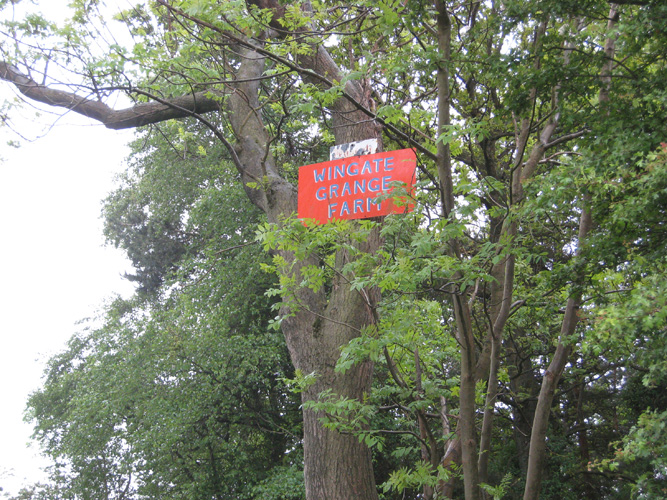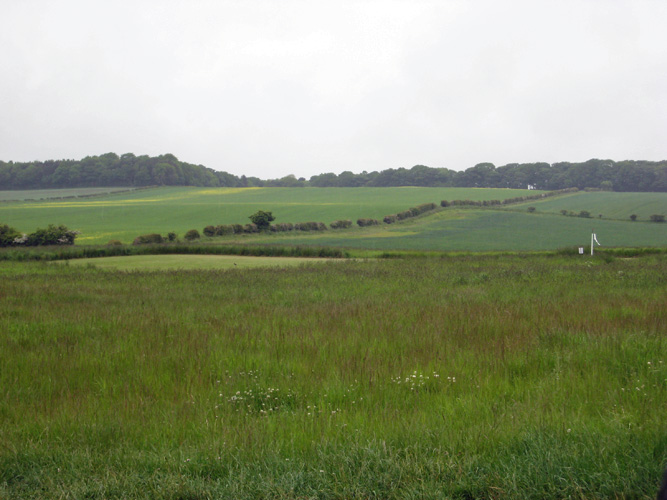On February 4, 1837, 79-year-old Robert Mitcheson, of Hurbuck, County Durham, England, shakily signed his will, splitting his properties between his two sons.1 He died three days later.
The only items he gave them outright were a bed, a bedroll and a chest of drawers each. They could choose the ones they preferred, and they were to divide the other household furniture equally. His other property was more valuable, so he named two friends as trustees.
Robert’s father, also named Robert Mitcheson (1726-1812), had been a farmer in nearby Knitsley. His grandfather, our common ancestor Robert Mitcheson (? – 1784), was a gentleman farmer in neighbouring Lanchester parish. The Robert Mitcheson who died in 1837 was a yeoman farmer, meaning he owned land: two farms and some other freehold land and buildings.

This Robert’s wife, Ann Roxby, had predeceased him. He had two sons, Robert and Thomas, and two surviving daughters, Jane and Mary. Son Robert (1801-1883) was to receive the rental income and profits from the farm at Biggin, which the will described as “closes or parcels of land.” Son Thomas (1811-1881) was to get the income from freehold land, houses and tenements at Allerheads, County Durham.
In addition, “all my farming stock crops of hay and corn standing and growing on Hurbuck [farm] and all other my estate and effects” were to be in trust and the two sons would get the profits.
Married women could not own land, so in his will, Robert promised each of his daughters a small annual income. The trustees were to pay Jane five pounds a year from the income from the farm at Biggin, while Mary would get three pounds a year from income from the property in Allerheads. Jane was married to George Weldon and had a son and three daughters. I do not know what happened to Mary.
Intrigued by the information about this family contained in the will, I did further research. Because they were landowners, Robert and Thomas were eligible to vote, and with their names on published lists of voters, it wasn’t hard to find them. Even after they left Hurbuck, it became clear that members of the family continued to farm, and they remained in this northern part of County Durham, within short distances of each other, for decades.
After their father died, Robert and Thomas lived at Hurbuck Farm for several years. The two were listed there in the 1837 Poll Book of voters.2 In the 1841 census – the first UK census to identify individuals – both were still single and living at Hurbuck, along with their 80-year-old Uncle John.3
When the 1851 census taker came along, Robert was living on the farm at Biggin with a live-in housekeeper, a house servant and two farm labourers.He does not appear to have married. The 1858 Post Office Directory shows he was still farming in Biggin,4 but a newspaper notice reveals he put the farm up for sale at auction that year.5
In the 1861 census, Robert Mitchinson, farmer, 56, born Knitsley, was living at Bolton house, Brandon Township along with several employees, including a carter, a housemaid and a dairy maid. After this, his circumstances appear to have changed. Perhaps he ran into financial or medical problems because, in the 1871 and 1881 censuses, Robert was a boarder and agricultural labourer at Broom, near Durham City. He died in 1883, at age 82, and was buried at nearby St Edmunds church cemetery, Bearpark.6
His brother Thomas (whose full name was Thomas John Mitcheson) married Mary Harle (1813-1893) in 1842 at Lanchester Parish Church. In the 1851 census, he was living on Hurbuck farm with his wife, three children and three farm servants. Two years later, the poll book listed Thomas as “farmer as occupier” in Burnopeside, and the 1861 and 1871 censuses counted the family at High Burnhopeside.7 Thomas died in Lanchester in 1881.

His son, John Thomas Mitcheson, born in 1845, maintained the family farming tradition at Park Head Farm, near Annfield Plain. A directory issued in 1894 showed that John was also Assistant Overseer and Collector of Income Tax.8 John and his wife, Barbara Ann Bean, had eleven children, including a son named Robert.
When John Thomas died in 1924, almost two centuries had passed since the 1728 baptism of his great-grandfather Robert Mitcheson at Lanchester Parish Church. In that time, this small corner of County Durham had changed dramatically. All around them, coal mines, collieries, quarries, roads and railroads had sprung up. The area was now an important coal mining area, but much of its farmland survived.
See also: Janice Hamilton, “The Legendary Robert Mitcheson of Knitsley.” Writing Up the Ancestors, March 15, 2022. https://www.writinguptheancestors.ca/2022/03/the-legendary-robert-mitcheson-of-knitsley.html
Notes:
Thank you to the owner of the MitchinsonStubbs public member tree on Ancestry. Not only is the family tree extensive, but it lists many sources so other researchers can easily confirm the information.
I am not sure what and where Allerheads was. There might have been a spelling error. There was a lead ore mine decades later at Allenheads, near Hexham, Northumberland.
Photos of High Burnhopeside Farm (grid NZ1846) and Hurbuck Farm (grid NZ1348) can be found on the website Geograph Photograph Every Grid Square, https://www.geograph.org.uk/.
Sources:
1. Search for this will on the Durham University Archives website, http://familyrecords.dur.ac.uk/nei/data/simple.php, and view it on Familysearch.org. “England, Durham, Diocese of Durham Original Wills, 1650-1857,” images, FamilySearch (https://familysearch.org/ark:/61903/3:1:9396-ZP22-C?cc=2358715&wc=9PQK-D5Q%3A1078420818 : 7 July 2014), DPRI/1/1837/M15 > image 1 of 3; Special Collections, Palace Green Library, Durham University, Durham.
2. “UK, Poll Books and Electoral Registers, 1538-1893;” Ancestry.com (http://ancestry.ca, database online, for Robert Mitchison, 1837, County Durham, Northern Division, accessed Dec. 30, 2021), citing “London, England, UK and London Poll Books”, London Metropolitan Archives and Guildhall Library.
3. 1841 England Census; Ancestry.com (http://ancestry.ca,database on-line, entry for Robert Mitcheson, County Durham, accessed March 26, 2022), Citing: Class: HO107; Piece: 301; Book: 17; Civil Parish: Lanchester; County: Durham; Enumeration District: 16b; Folio: 13; Page: 11; Line: 1; GSU roll: 241348; original dataCensus Returns of England and Wales, 1841. Kew, Surrey, England: The National Archives of the UK (TNA): Public Record Office (PRO), 1841.
4. “UK, City and County Directories, 1766-1946,” Ancestry.com (http://ancestry.ca, database online, accessed Dec. 19, 2021), entry for Robert Mitcheson), 1858 Post Office Directory.
5. “Farm of Land at Biggin to be sold at Auction”, Durham Chronicle, March 5, 1858, Findmypast.com, (www.FindMyPast.com, online database, accessed March 15, 2022).
6. England, Select Deaths and Burials, 1538-1991” Ancestry.com (http://ancestry.ca online database, entry for Robert Mitcheson, accessed March 26, 2022), Original data: England Deaths and Burials, 1538-1991. Salt Lake City, Utah: FamilySearch, 2013.
7. “1861 England Census” Ancestry.com (http://ancestry.ca,database on-line, entry for Thomas J. Mitchanson, Durham, accessed March 26, 2022), citing: Class RG9, Piece: 3736; Folio: 63; Page: 1; GSU roll: 543179; Enumeration District: 4e; original dataCensus Returns of England and Wales, 1861. Kew, Surrey, England: The National Archives of the UK (TNA): Public Record Office, 1861.
8. “UK, City and County Directories, 1766-1946,” Ancestry.com (http://ancestry.ca, database online, entry for John Thomas Mitcheson, accessed March 26, 2022), Whellan’s Directory 1894.


